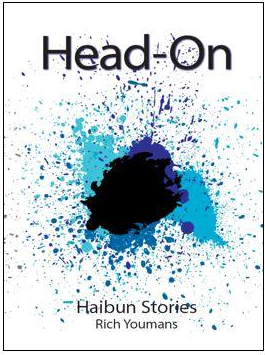|
Rich Youmans, Head-On: Haibun Stories, A Review by Bob Lucky
Rich Youmans, Head-On: Haibun Stories, Red Bird Chapbooks, 2019, 32 pages, $12 USD.
 Rich Youmans has been a presence in the haibun community for over two decades, and this collection of haibun, Head-On, clearly demonstrates why. Youmans is a craftsman. There’s not one haibun in this chapbook that couldn’t be used to teach a master class. Rich Youmans has been a presence in the haibun community for over two decades, and this collection of haibun, Head-On, clearly demonstrates why. Youmans is a craftsman. There’s not one haibun in this chapbook that couldn’t be used to teach a master class.
First, and perhaps foremost, he can write haiku, from a conventional three-liner:
silence,
the applause deepens
the summer leaves (22)
to a monostich haiku, which comprise more than half of the haiku in the book:
wishbone’s crack all the blue sky (20)
In one haibun, he has two clusters of three monostich haiku that work as part of the narrative, which is generally frowned upon as breaking the dictum about haiku standing alone in a haibun. It works well here because of where Youmans has placed these clusters at pivotal moments in the narrative. Both clusters come after a flood of memories as the protagonist sits stalled at an intersection, and they crystallize a moment those memories reveal, functioning somewhat as flashbacks:
windshield through a jagged hole, night rushes in
on your tongue the taste of iron and her name
after the funeral all the ceiling cracks led nowhere
you think of her as the traffic light burns red and the rain falls – the night pouring into itself, over and over. (13)
Although the clusters do serve as part of the narrative, the first and third haiku in the cluster above could easily stand alone as well. There is resonance between the prose and the haiku, but not in the way you usually expect.
Although this is a short collection of only thirteen haibun, they come in a range of structures. Many haibun writers – and I can feel the finger pointing at me – fall into a rut of cranking out a block of prose with a capping haiku, unthinkingly clinging to that structure with the tenacity of an elementary school teacher hanging onto the 5-7-5 haiku lessons. There are only two such haibun here. Two others have the prose enveloped with a beginning and ending haiku. One haibun closes with a series of six haiku. Most have haiku inserted between the blocks of prose.
Which brings us to this point: these haibun are identified in the subtitle as haibun stories. Haibun stories and tanka tales are two terms I’ve yet to fully understand the need for, but this collection seems to warrant the use of the term. All but two of the haibun are in third person. The theme of the collection may be summed up in a line from the haibun “The Life You Save”:
“he wonders what the spider is thinking – whether it’s scared, or confused, or just amazed at how everything it knows can change so suddenly.” (23)
In some ways, this collection is yearning to be a novella-in-haibun. As the haibun were all previously published over a span of approximately 15 years (the acknowledgment page doesn’t provide dates for all the publications), it is clear Youmans has been exploring this theme for some time.
Just past halfway through this collection, Youmans shifts point of view to first person in two haibun, “Sleight of Hand” and “For You.” The focus is suddenly on the relationship between a narrator and his father, and the father and his wife. This throws the other pieces into a relief of sorts. It’s an emotional moment in the overall narrative, assuming we can link this together into a novella. If there is an epiphany in this collection this is it. After this, the haibun cover the narrator letting go of an earlier tragic relationship and finding joy in a new one.
And so, just as each haibun in Head-On could be part of a master class, the chapbook itself could be a guide for putting together a collection.
|

